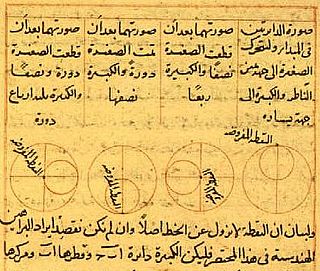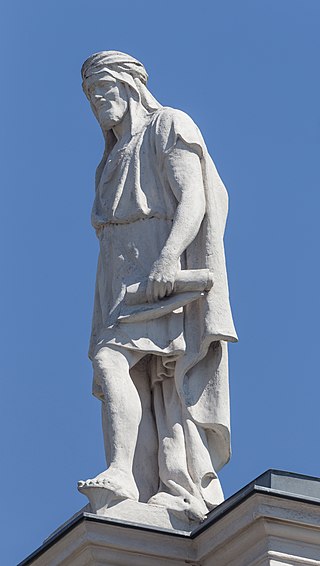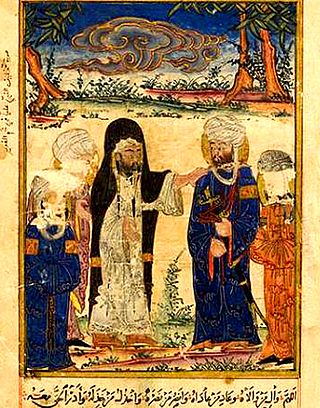
Abū Bakr Muḥammad ibn Yaḥyā ibn al-‘Abbās al-Ṣūlī, was a Turkic scholar and a court companion of three Abbāsid caliphs: al-Muktafī, his successor al-Muqtadir, and later, al-Rāḍī, whom he also tutored. He was a bibliophile, wrote letters, editor-poet, chronicler, and a shatranj player. His contemporary biographer Isḥāq al-Nadīm tells us he was “of manly bearing.” He wrote many books, the most famous of which are Kitāb Al-Awrāq and Kitāb al-Shiṭranj.

Science in the medieval Islamic world was the science developed and practised during the Islamic Golden Age under the Umayyads of Córdoba, the Abbadids of Seville, the Samanids, the Ziyarids, the Buyids in Persia, the Abbasid Caliphate and beyond, spanning the period roughly between 786 and 1258. Islamic scientific achievements encompassed a wide range of subject areas, especially astronomy, mathematics, and medicine. Other subjects of scientific inquiry included alchemy and chemistry, botany and agronomy, geography and cartography, ophthalmology, pharmacology, physics, and zoology.

Abu Rayhan Muhammad ibn Ahmad al-Biruni commonly known as al-Biruni, was a Khwarazmian Iranian scholar and polymath during the Islamic Golden Age. He has been called variously the "founder of Indology", "Father of Comparative Religion", "Father of modern geodesy", and the first anthropologist.

Ghazni, historically known as Ghaznain (غزنين) or Ghazna (غزنه), also transliterated as Ghuznee, and anciently known as Alexandria in Opiana, is a city in southeastern Afghanistan with a population of around 190,000 people. The city is strategically located along Highway 1, which has served as the main road between Kabul and Kandahar for thousands of years. Situated on a plateau at 2,219 metres (7,280 ft) above sea level, the city is 150 kilometres (93 mi) south of Kabul and is the capital of Ghazni Province.

Abū al-ʿAbbās Aḥmad ibn Muḥammad ibn Kathīr al-Farghānī also known as Alfraganus in the West, was an astronomer in the Abbasid court in Baghdad, and one of the most famous astronomers in the 9th century. Al-Farghani composed several works on astronomy and astronomical equipment that were widely distributed in Arabic and Latin and were influential to many scientists. His best known work, Kitāb fī Jawāmiʿ ʿIlm al-Nujūmi, was an extensive summary of Ptolemy's Almagest containing revised experimental data. Christopher Columbus, used Al Farghani’s calculations for his voyages to America. In addition to making substantial contributions to astronomy, al-Farghani also worked as an engineer, supervising construction projects on rivers in Cairo, Egypt. The lunar crater Alfraganus is named after him.

Abū al-Wafāʾ Muḥammad ibn Muḥammad ibn Yaḥyā ibn Ismāʿīl ibn al-ʿAbbās al-Būzjānī or Abū al-Wafā Būzhjānī was a Persian mathematician and astronomer who worked in Baghdad. He made important innovations in spherical trigonometry, and his work on arithmetics for businessmen contains the first instance of using negative numbers in a medieval Islamic text.

The digit or finger is an ancient and obsolete non-SI unit of measurement of length. It was originally based on the breadth of a human finger. It was a fundamental unit of length in the Ancient Egyptian, Mesopotamian, Hebrew, Ancient Greek and Roman systems of measurement.

Medieval Islamic astronomy comprises the astronomical developments made in the Islamic world, particularly during the Islamic Golden Age, and mostly written in the Arabic language. These developments mostly took place in the Middle East, Central Asia, Al-Andalus, and North Africa, and later in the Far East and India. It closely parallels the genesis of other Islamic sciences in its assimilation of foreign material and the amalgamation of the disparate elements of that material to create a science with Islamic characteristics. These included Greek, Sassanid, and Indian works in particular, which were translated and built upon.
This article presents lists of the literary events and publications in the 11th century.
Islamic cosmology is the cosmology of Islamic societies. It is mainly derived from the Qur'an, Hadith, Sunnah, and current Islamic as well as other pre-Islamic sources. The Qur'an itself mentions seven heavens.

Al-Mas'udi was an Arab historian, geographer and traveler. He is sometimes referred to as the "Herodotus of the Arabs". A polymath and prolific author of over twenty works on theology, history, geography, natural science and philosophy, his celebrated magnum opus Murūj al-Dhahab wa-Ma'ādin al-Jawhar, combines universal history with scientific geography, social commentary and biography, and is published in English in a multi-volume series as The Meadows of Gold and Mines of Gems.
Medieval Islamic geography and cartography refer to the study of geography and cartography in the Muslim world during the Islamic Golden Age. Muslim scholars made advances to the map-making traditions of earlier cultures, particularly the Hellenistic geographers Ptolemy and Marinus of Tyre, combined with what explorers and merchants learned in their travels across the Old World (Afro-Eurasia). Islamic geography had three major fields: exploration and navigation, physical geography, and cartography and mathematical geography. Islamic geography reached its apex with Muhammad al-Idrisi in the 12th century.

The Remaining Signs of Past Centuries by Abū Rayhān al-Bīrūnī, is a comparative study of calendars of different cultures and civilizations, interlaced with mathematical, astronomical, and historical information, exploring the customs and religions of different peoples.

During the High Middle Ages, the Islamic world was at its cultural peak, supplying information and ideas to Europe, via Al-Andalus, Sicily and the Crusader kingdoms in the Levant. These included Latin translations of the Greek Classics and of Arabic texts in astronomy, mathematics, science, and medicine. Translation of Arabic philosophical texts into Latin "led to the transformation of almost all philosophical disciplines in the medieval Latin world", with a particularly strong influence of Muslim philosophers being felt in natural philosophy, psychology and metaphysics. Other contributions included technological and scientific innovations via the Silk Road, including Chinese inventions such as paper and gunpowder.
Edward Stewart Kennedy was a historian of science specializing in medieval Islamic astronomical tables written in Persian and Arabic.
Bahmanagān or BAHMANJANA was a Zoroastrian Iranian festival which was maintained until the Mongol invasion by Iranian Muslims. It takes place on the 2nd day of Bahman.
Sirāj ud-DīnMuhammad ibn Muhammad ibn 'Abd ur-Rashīd Sajāwandī also known as Abū Tāhir Muhammad al-Sajāwandī al-Hanafī and the honorific Sirāj ud-Dīn was a 12th-century Hanafi scholar of Islamic inheritance jurisprudence, mathematics astrology and geography. He is primarily known for his work Kitāb al-Farāʼiḍ al-Sirājīyah, commonly known simply as "the Sirājīyah", which is a principal work on Hanafi inheritance law. The work was translated into English by Sir William Jones in 1792 for subsequent use in the courts of British India. He was the grand-nephew of qari Muhammad ibn Tayfour Sajawandi. He lies buried in the Ziārat-e Hazrat-o 'Āshiqān wa Ārifān in Sajawand.
Ibn Bashkuwāl, he was Khalaf ibn ‘Abd al-Malik ibn Mas'ud ibn Musa ibn Bashkuwāl ibn Yûsuf al-Ansârī, Abū'l-Qāsim, , was an influential Andalusian traditionist and biographer working in Córdoba and Seville.
Sadr al-Shari'a al-Asghar, also known as Sadr al-Shari'a al-Thani, was a Hanafi-Maturidi scholar, faqih (jurist), mutakallim (theologian), mufassir, muhaddith, nahawi (grammarian), lughawi (linguist), logician, and astronomer, known for both his theories of time and place and his commentary on Islamic jurisprudence, indicating the depth of his knowledge in various Islamic disciplines.












